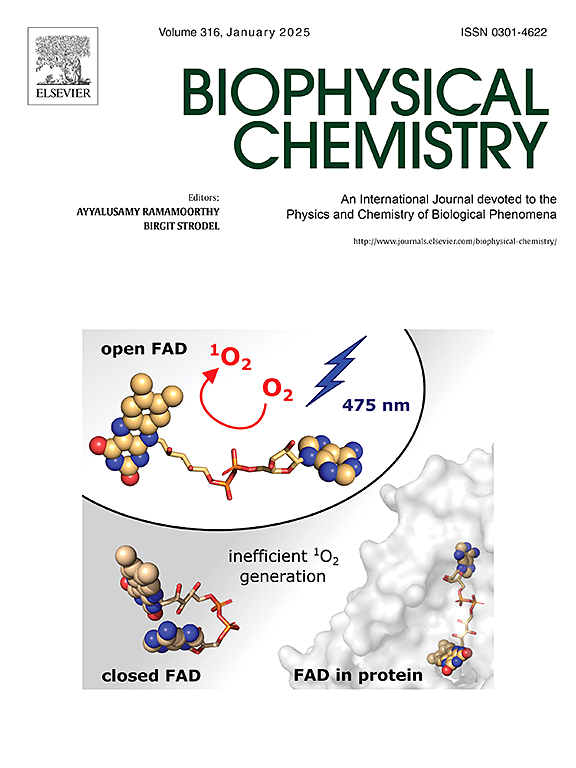Inhibition of nucleation and disruption of amyloid fibrillation in human lysozyme aggregation by a potent Cu(II) flufenamate chemotherapeutic drug candidate
IF 2.2
3区 生物学
Q2 BIOCHEMISTRY & MOLECULAR BIOLOGY
引用次数: 0
Abstract
Amyloid fibrillation is a key feature in the pathogenesis of various protein misfolding diseases. This process is driven by both primary and secondary nucleation mechanisms. Many small molecules are known to modulate protein aggregation, with certain anticancer drugs demonstrating the ability to interfere with amyloid formation. In lieu of above rationale, with the aim to repurpose anticancer drugs for other therapeutic remedies, we investigated the potential of an ionic anticancer chemotherapeutic drug candidate, namely aquachlorobis(DACH)copper(II) flufenamate complex; [{Cu(DACH)2(H2O)Cl}.(fluf)] for the inhibition of amyloid formation in Human lysozyme protein. Utilizing various biophysical techniques, viz., distinctive dye binding assays, confocal microscopy, and dynamic light scattering experiments, the potency of Cu(II) complex to inhibit human lysozyme fibrillation was studied. Our findings demonstrated that Cu(II) complex significantly disrupted amyloid fibrillation by targeting and inhibiting both primary and secondary nucleation pathways. The results indicated the high effectiveness of Cu(II) complex in preventing Human Lysozyme fibrillation, making it a promising candidate for addressing amyloidosis and paving a way for repurposing anticancer drug scaffolds as anti-AD agents.

一种有效的Cu(II)氟芬酸盐化疗候选药物对人溶菌酶聚集过程中成核和淀粉样纤维断裂的抑制作用
淀粉样蛋白纤颤是各种蛋白质错误折叠疾病发病机制的关键特征。这一过程是由原生成核机制和次生成核机制共同驱动的。众所周知,许多小分子可以调节蛋白质聚集,某些抗癌药物显示出干扰淀粉样蛋白形成的能力。为了替代上述原理,为了将抗癌药物重新用于其他治疗方法,我们研究了一种离子抗癌化疗候选药物的潜力,即氯仿水(DACH)铜(II)氟胺酸络合物;[{Cu(DACH)2(H2O)Cl}.(fluf)]抑制人溶菌酶蛋白淀粉样蛋白的形成。利用各种生物物理技术,即独特的染料结合试验,共聚焦显微镜和动态光散射实验,研究了Cu(II)配合物抑制人类溶菌酶颤动的效力。我们的研究结果表明,Cu(II)复合物通过靶向和抑制初级和次级成核途径显著破坏淀粉样蛋白纤颤。结果表明,Cu(II)复合物在预防人溶菌酶纤颤方面具有很高的有效性,使其成为解决淀粉样变性的有希望的候选者,并为抗癌药物支架作为抗ad药物的重新用途铺平了道路。
本文章由计算机程序翻译,如有差异,请以英文原文为准。
求助全文
约1分钟内获得全文
求助全文
来源期刊

Biophysical chemistry
生物-生化与分子生物学
CiteScore
6.10
自引率
10.50%
发文量
121
审稿时长
20 days
期刊介绍:
Biophysical Chemistry publishes original work and reviews in the areas of chemistry and physics directly impacting biological phenomena. Quantitative analysis of the properties of biological macromolecules, biologically active molecules, macromolecular assemblies and cell components in terms of kinetics, thermodynamics, spatio-temporal organization, NMR and X-ray structural biology, as well as single-molecule detection represent a major focus of the journal. Theoretical and computational treatments of biomacromolecular systems, macromolecular interactions, regulatory control and systems biology are also of interest to the journal.
 求助内容:
求助内容: 应助结果提醒方式:
应助结果提醒方式:


